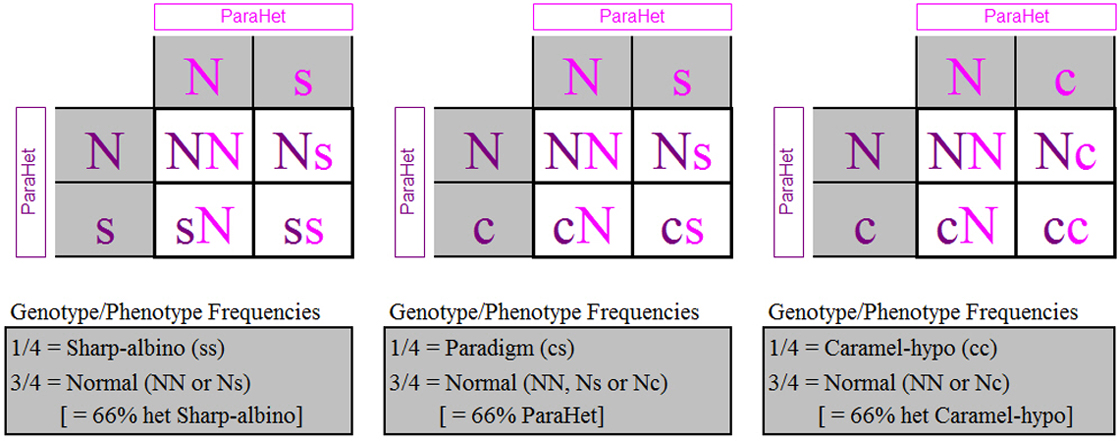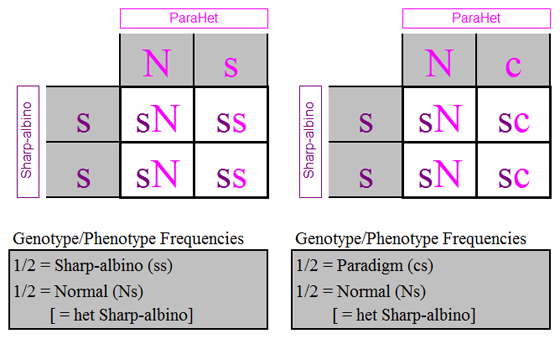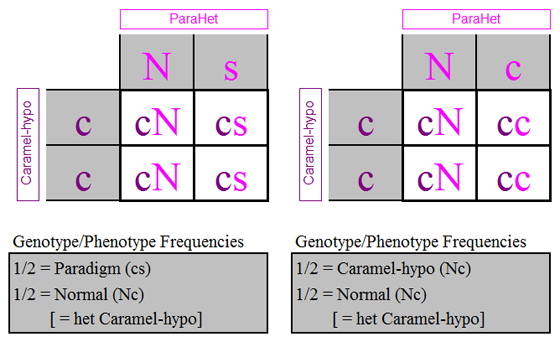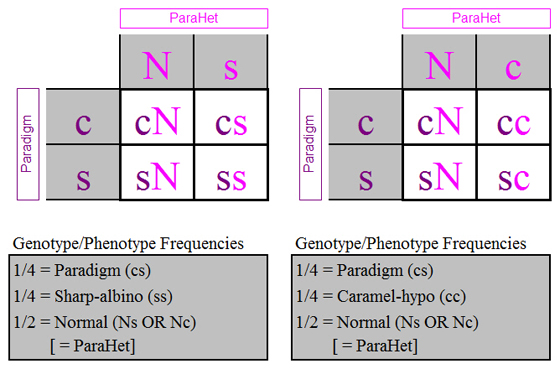|
What can I do with a ParaHet?
So, we have a ParaHet, which we know is heterozygous for either Sharp-albino
or Caramel‑hypo but we don’t know which. Clearly, the two questions
we are interested in answering are, “What are the breeding trials that could be performed to determine whether it is
a het Sharp‑albino or a het Caramel‑hypo?” and “What offspring do we have the potential to produce
from these breeding trials?”
The first option we will consider is breeding the ParaHet to another ParaHet. In selecting any two ParaHets at random, we can have either two het Sharp‑albinos
(probability 1/4), two het Caramel‑hypos (probability 1/4), or one of each (probability 1/2). The Punnett squares for each of these three test crosses and the associated expected offspring summaries
are shown below.

|
| Click on the image to view full size. |
So, if we breed two ParaHets we would expect approximately 1/4 of the litter
to be either Sharp-albino, Caramel-hypo, or Paradigm. If there are Sharp-albinos
in the litter, both parents are then known to be het Sharp‑albino. If there
are Caramel‑hypos in the litter, both parents are then known to be het Caramel‑hypo. Finally, if there are Paradigms in the litter, then we know that one parent is het Sharp‑albino and
the other parent is het Caramel‑hypo – though we know we have one of each, we cannot tell which parent is which,
but who cares…we made Paradigms from just a couple of ParaHets!
The even better news is that producing Paradigms is the most likely outcome
as indicated by the probabilities above. To repeat, in choosing any two ParaHets
at random, the odds are 1/4 that both are het Sharp‑albino and thus will produce Sharp‑albinos, and 1/4 that both
are het Caramel‑hypo and thus will produce Caramel‑hypos. But the
odds are 1/2 that we have one of each and that they will produce Paradigms. We can also say that the odds are 3/4 that
we will produce either Paradigms or Caramel-hypos, the two more desirable results (only so because the Sharp-albino is much
more common).
These examples also point out a further advantage of using the name ParaHet. In the cross above that produces Paradigms, the remaining 3/4 of the litter consists
of 1/3 normal, 1/3 het Sharp‑albino and 1/3 het Caramel‑hypo. It
is equivalent to say that 2/3 of these are ParaHets. As such, we can simply call
all of the normal‑appearing offspring in this litter 66% possible ParaHets (or just 66% ParaHets) analogous to the way
we would arrive at the more familiar 66% het Sharp‑albinos from a breeding of two het Sharp‑albinos, for example.
What Else Can I do with a ParaHet?
The other possible ParaHet breeding trials include crossing a ParaHet with
a Sharp‑albino, a Caramel‑hypo, or a Paradigm (a ParaHet could also be crossed to a het Sharp‑albino or
a het Caramel‑hypo; those outcomes are already described above in the analysis of the ParaHet to ParaHet cross). Each of these crosses and the possible outcomes are shown below. The Punnett squares on the left show the case in which the ParaHet is a het Sharp‑albino, and those
on the right show the case in which the ParaHet is a het Caramel‑hypo.



Note that in each of these cases, the phenotypes of the offspring allow us to determine whether the parent ParaHet is
a het Sharp‑albino or a het Caramel‑hypo.
Continue to "4. Multiple Traits"
Back to "2. Multiple Alleles"
Back to the "Genetics and Paradigms" Page
|

